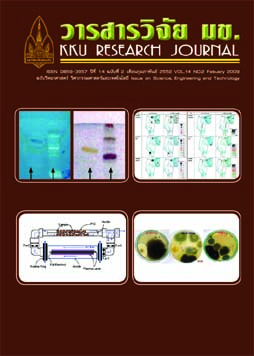Application of atmospheric plasma : fungal decontamination on grains (Thai)
Main Article Content
Abstract
Grains are major agricultural products of Thailand. They must "ideally" have no pathogenic or toxinproducing microorganisms which can probably cause plant diseases resulting in economic loss. Nowadays many techniques or fungal controlling approaches can be used for controlling fungal contamination such as irradiation, gas etc. These can be considered as possible risks at the working level. Development of a grain sterilization method might reduce grain/nutritional damage and other risks. In this study, an atmospheric plasma was constructed by applying a 15 kV, 500 Hz voltage on a flat electrode. The obtained atmospheric plasma did reduce, compared to untreated set of grains, a number of contaminated fungi (Total mold) from groundnut surface. This dramatic reduction of mold was achieved by a 15-minute treatment and resulted in fungal quantity of less than 10 cfu/g. Moreover the generating plasma did not damage or cause abnormal germination of groundnuts after treatment.


